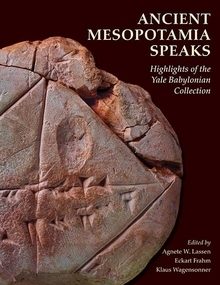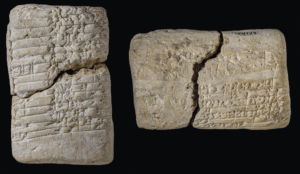
Editor’s Note: The fascinating details of ancient civilization come alive most lucently through written records, and it was in ancient Mesopotamia when writing first advanced to the point where the human record really began to tell a story about the past. Mesopotamia has left us with a massive legacy of information about this ancient people’s literature, beliefs, government, diplomacy, conflicts, science, economy, trade, family life, and even their personal relationships, food and cooking. In this [edited] essay excerpt, author and scholar Klaus Wagensonner gives us an intimate view into how the ancient scribes, the creators of Mesopotamia’s vast written record, learned their craft.
Becoming a Scribe—Step by Step
“Go! Knead your tablet! Make it! Write it! Finish your tablet!”—these brief instructions in a bilingual vocabulary offer a short glimpse into the daily tasks of a scribe. The apprentice started his training as a child, probably at the age of five or six years. The first step was to cover the basics: transforming a lump of moist clay into a tablet. The next challenge was to use a reed stylus to form intelligible signs on the clay. A famous line from a literary work points out, “The beginning of the scribal art is the single wedge”. To gain some routine, the student impressed his stylus over and over again into the clay (Figure 1), producing the horizontal, vertical, and oblique wedges of which cuneiform characters were comprised. Similar exercises can still be found in the late first millennium BC.
____________________________
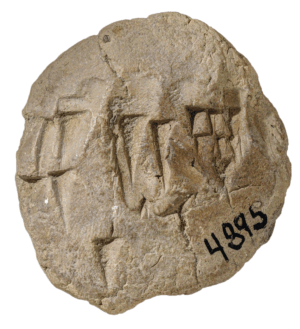
Fig. 1: The first wedges, a simple sign exercise. From Klaus Wagensonner
____________________________
Handling a reed stylus is not straightforward and requires a lot of practice, as is demonstrated by the many surviving exercise tablets from Mesopotamia. The signs formed by the hands of young apprentices are often rather crude when compared with those of their skilled instructors (Figure 2).
____________________________
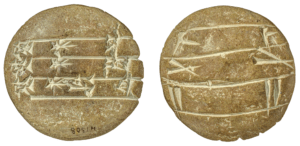
Fig. 2: “School lentil” with teacher’s (obverse, left) and student’s (reverse, right) hand. From Klaus Wagensonner
____________________________
The square, two–column “Type II”—and round “Type IV”—tablets were the main teaching tools used in elementary education. In the next stage of learning, students had to familiarize themselves with syllables, which were covered by several lists. While so-called syllable alphabets (Figure 2, right; Figure 3, left) helped students practice common signs, another list referred to as TU-TA-TI was arranged according to sounds (Figure 3, right). The entries of the TU-TA-TI lists are organized in groups of three, starting with the sign values tu, ta, ti followed by nu, na, ni, and so forth.
____________________________

Fig. 3: Practicing syllables: Syllabary Alphabet A (on left) and TU-TA-TI (on right). From Klaus Wagensonner
____________________________
In the next phase of their studies, the “sons of the tablet house” (Sumerian: d u m u e 2 – d u b – b a – a ) had to expand their vocabulary. This was achieved by copying an important thematic list, a forerunner of what would eventually become a compendium spanning thousands of entries that according to its first entry was referred to as Ura, “loan.” This long list contained designations of trees and wooden objects, other raw materials, animals, geographic entities, and also food items. During the early second millennium, these designations were still almost exclusively Sumerian. In copying extracts, students usually just sampled the many entries of the list. On the “Type II” tablet, for instance, the student copied lines from Ura concerning domestic animals. At this stage, he was still far from being as accomplished as the scribe of a small tablet inscribed in an astonishingly tiny script, which contains almost two hundred entries belonging to the same thematic list; it dates a few centuries later (Figure 4).
_______________________________
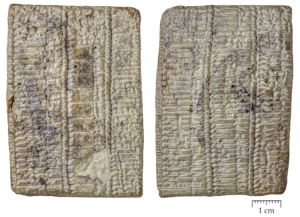
Fig. 4: A copy of the thematic list Ura dealing with wooden objects. From Klaus Wagensonner
_______________________________
After Ura, students studied more advanced lists, including metrological lists and mathematical tables, but also syllabaries (such as Ea and Diri) and word lists whose entries are arranged according to their initial signs (for example, Izi, Kagal, and Nigga). An important feature of these advanced exercises is the increased use of Akkadian translations either in a separate sub- column or added as a gloss in smaller script.
Students were, moreover, introduced to a compendium on legal expressions that bore the title Ki-ulutinbishe, “at the agreed time.” Learning specific legal clauses was an important task for scribes who would later enter positions in the administration.
Ki-ulutinbishe also prepared the students for the next stage in the scribal training, which dealt with model contracts, among other things. Through them students would learn how to contextualize what they had learned before: personal names, legal phrases, metrology, and vocabulary such as specific commodities. As a rule, model contracts lack a witness list and a date, which distinguishes them from actual contracts. Some model contracts were combined into larger collections (Figure 5).
_____________________________
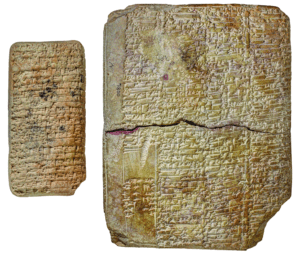
Fig. 5: A single model court case concerning inheritance (on left) and a collection of model court cases (on right). From Klaus Wagensonner
_____________________________
Another exercise during this stage in a scribe’s education, and at the same time an avenue toward more advanced training in Sumerian literature, involved short sayings or proverbs (Figure 6), many of which were again put together in longer collections. Occasionally, some of the proverbs copied by the students would cast some interesting light on their own profession: “A scribe may know only one single entry; but when his hand is good, he is indeed a scribe,” or “A scribe whose hand can keep up with the mouth is indeed a scribe”.
_____________________________
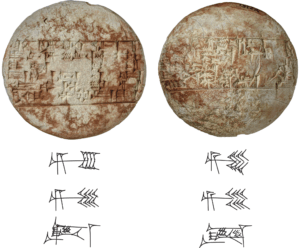
Fig. 6: A school lentil with instructor’s model text (a proverb) on the obverse (left) and student’s copy on the reverse (right). Below, a comparison of three different signs between instructor and student. From Klaus Wagensonner
_____________________________
At this stage, the student had reached a point where he could handle the reed stylus properly and was relatively well acquainted with the intricacies of the cuneiform script. It is interesting that his entire scribal education had been based on Sumerian, which was by and large a dead language during the Old Babylonian period. The spoken vernacular, Akkadian, appears to have played a very limited role in school. If we are to believe a passage from Schooldays, one of the Old Babylonian literary texts dealing with school work, it seems, in fact, to have been actively repressed: “The Sumerian instructor (said), ‘You spoke in Akkadian!’ (and) beat me. My master (said), ‘Your hand is not good!’ (and) hit me”. Despite such statements, Akkadian model letters must have had a place in the curriculum (Figure 7). But according to the Sumerian “school debate” texts, knowing how to write simple texts was not the main goal of a higher education. In one of them, an advanced scribe by the name Girini- isa belittles the student letter; “that’s the limit for you!” (Dialogue 3, line 20). The yardstick of true learnedness was apparently that one knew things that were absolutely useless from a practical point of view, but conducive to creating an “esprit de corps” among the members of the scribal elite. And one of the highest achievements in this regard was to become acquainted with Sumerian literature.
_______________________________

Fig. 7: School text with a name list on the obverse (on left) and draft of a letter (reverse, on right) written perpendicular to the obverse. From Klaus Wagensonner
_______________________________
The “School” and Sumerian Literature
In the more advanced stages of the scribal education, the use of typical school texts decreased. Students copied instead from memory parts of major Sumerian literary compositions. Occasionally, we can even trace how long it took them to finish their work on a specific text and the sequence in which they copied certain works. The Yale Babylonian Collection holds six extract tablets, each written and dated by a scribe named Qishti-Ea. Thus, we know that on the twentieth day of month nine in year one of king Samsu-iluna (reigned 1749–1712 BC), he wrote the first half of a literary letter and completed this task on a second tablet five days later. A tablet listing incipits (that is, titles) of texts suggests that scribes copied out long bodies of text in sections as daily tasks.
Although we often lack the archaeological context, in a few instances our documentation is so dense that it almost seems we are able to look over the shoulders of the young scribes and join them on their “bench.” On the eleventh day of month twelve of an unknown year, for instance, Ilshu-iddishu and Iddin-Eshtar got the same assignment: they had to write out lines 1 to 31 of a Sumerian hymn known as Lipit-Eshtar A. While the distribution of lines on either side of the tablets and their spacing are the same, spelling variants suggest that the scribes had to write these lines from memory (Figure 8).
_____________________________

Fig. 8: Two copies of the hymn Lipit-Eshtar A (both reverse with colophon). From Klaus Wagensonner
_____________________________
In the early second millennium, the corpus of Sumerian literature grew significantly. For about 175 of the approximately 550 known literary compositions, we have manuscripts that can be linked to scribal education.
Graduation
Apart from tablets written in the first year of Samsu-iluna, Qishti-Ea also produced tablets that date to his eleventh year. One wonders whether Qishti-Ea really spent such a long time finishing his training. But the tablets we have at our disposal are all extracts from literary compositions and thus typical products of a scribal education.
Even the extracts produced by an advanced apprentice such as Qishti-Ea do not match in quality and scope the many large multicolumn tablets (so-called Type I or Type M) and prisms (Type P) that contain full copies of literary texts, sometimes even collections of several different compositions. In modern literature, these types of texts are often considered “school texts” as well, but their level of proficiency suggests that they were written by highly trained and experienced scribes.
A noteworthy example are four strikingly similar six-sided prisms clearly written by the same scribe in month twelve of the tenth year of king Samsu-iluna and probably originating from Larsa (Figure 9). Each of these prisms contains a full copy of a Sumerian literary composition, known in modern terminology as Lipit-Eshtar B, Iddin-Dagan B, Enlil-bani A, and Nisaba A. These four texts form a group called the Tetrad. Because of their comparatively simple grammar, they were first studied shortly after the elementary stage of education was completed.
What, then, was the purpose of the prisms, which were obviously written by a more advanced scribe?
Without archaeological context, the question is difficult to answer, but one could entertain the possibility that scribes who had finished their training and wished to mark their transition into a new stage in their lives deposited prisms such as these in the local shrine of Nisaba, the goddess of writing, as a sort of “final essay.”
__________________________
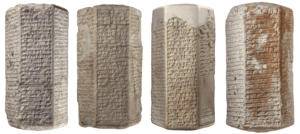
Fig. 9: Four six-sided prisms written by the same scribe. From Klaus Wagensonner
__________________________
From Ancient Mesopotamia Speaks: Highlights of the Yale Babylonian Collection, edited by Agnete W. Lassen, Eckart Frahm, and Klaus Wagensonner, distributed by Yale University Press for the Yale Peabody Museum of Natural History in April 2019. From Chapter Eleven by Klaus Wagensonner. Reproduced by permission.
A special exhibition by the same name at the Yale Peabody Museum of Natural History runs until June 30, 2020. The book associated with the exhibition can be purchased at Yale University Press.

